
French cuisine is the cooking traditions and practices from France. It has been influenced over the centuries by the many surrounding cultures of Spain, Italy, Switzerland, Germany and Belgium, in addition to the food traditions of the regions and colonies of France.

Fromage blanc is a fresh cheese originating from the north of France and southern Belgium. The name means "white cheese" in French. Fromage frais differs from fromage blanc in that, according to French legislation, fromage frais must contain live cultures when sold, whereas with fromage blanc, fermentation has been halted.
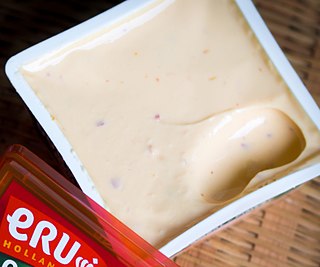
Cheese spread is a soft spreadable cheese or processed cheese product. Various additional ingredients are sometimes used, such as multiple cheeses, fruits, vegetables and meats, and many types of cheese spreads exist. Pasteurized process cheese spread is a type of cheese spread prepared using pasteurized processed cheese and other ingredients.
Daniel Boulud is a French chef and restaurateur with restaurants in New York City, Palm Beach, Miami, Toronto, Montréal, Singapore, the Bahamas, the Berkshires and Dubai. He is best known for his eponymous restaurant Daniel, in New York City, which currently holds two Michelin stars.

A bouchon is a type of restaurant found in Lyon, France, that serves traditional Lyonnaise cuisine, such as sausages, coq-au-vin, "salade lyonnaise" duck pâté or roast pork. Compared to other forms of French cooking such as nouvelle cuisine, the dishes are quite hearty. There are approximately twenty officially certified traditional bouchons, but a larger number of establishments describe themselves using the term.

Ossau-Iraty is an Occitan-Basque cheese made from sheep milk.

Lyon, also spelled in English as Lyons, is the third-largest city and second-largest metropolitan area of France. It is located at the confluence of the rivers Rhône and Saône, to the northwest of the French Alps, 391 km (243 mi) southeast of Paris, 278 km (173 mi) north of Marseille, 113 km (70 mi) southwest of Geneva, 50 km (31 mi) northeast of Saint-Étienne.
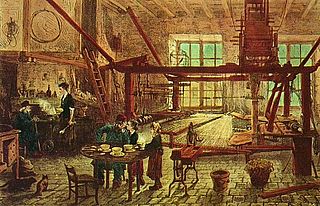
The canuts were Lyonnais silk workers, often working on Jacquard looms. They were primarily found in the Croix-Rousse neighbourhood of Lyon in the 19th century. Although the term generally refers to Lyonnais silk workers, silk workers in the nearby commune of l'Arbresle are also called canuts.

The Canut revolts is the collective name for the major revolts by Lyonnais silk workers which occurred in 1831, 1834 and 1848. They were among the first well-defined worker uprisings of the period known as the Industrial Revolution.

La Croix-Rousse is a hill 254 metres (833 ft) high in the city of Lyon, France, as well as the name of a neighborhood located on this hill. The neighborhood is divided into les pentes and le plateau. This zone is served by Metro line . With 18th century architecture, including unique dwellings for labourers, La Croix-Rousse was inscribed on the UNESCO World Heritage List in 1998 to protect Lyon's long history as an important European city.
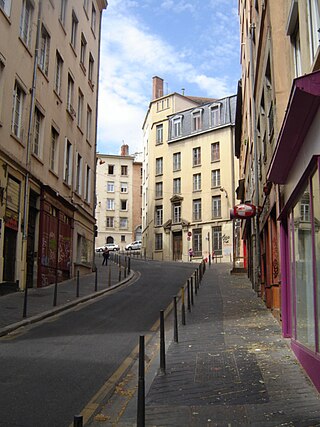
The Montée des Carmélites is one of the oldest streets of Lyon, dating from Roman times, located in the 1st arrondissement of Lyon. It connects the Saint-Vincent quarter to the Plateau de la Croix-Rousse. It is situated between the rue de la Tourette and the rue Ray Fernand, and ends at the intersection of the rue Burdeau, rue du Jardin des Plantes and rue de l'Annonciade.

The Cour des Voraces, also called Maison de la République, is a courtyard building in the Pentes quarter, in the 1st arrondissement of Lyon, famous for its enormous six-floor stairway. It is an impressive traboule, a covered passage with entrances on Place Colbert, Montée Saint-Sébastien and Rue Imbert-Colomès.
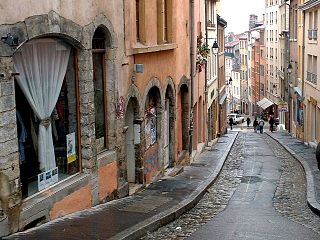
The Montée de la Grande Côte, or the Montée de la Grande-Côte, is a street of La Croix-Rousse quarter, in the 1st arrondissement of Lyon, which connects the Terreaux quarter and the Plateau de la Croix Rousse. It is characterized by a high elevation and is more narrow at the bottom. The street belongs to the zone that is classified as World Heritage Site by UNESCO.

The Rue d'Austerlitz is a street in the 4th arrondissement of Lyon, in La Croix-Rousse quarter. It begins on the rue du Mail, at the corner of Place de la Croix-Rousse, crosses the rue du Pavilion, the rue de Belfort and the rue Aimé Boussange, and ends on Place Bellevue. Its name refers to the Battle of Austerlitz, one of the greatest victories of Napoleon. There are metro and velo'v stations.

Lyonnaise cuisine refers to cooking traditions and practices centering on the area around the French city of Lyon and historical Lyonnais culinary traditions.
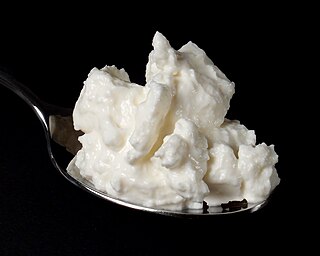
Quark or quarg is a type of fresh dairy product made from milk. The milk is soured, usually by adding lactic acid bacteria cultures, and strained once the desired curdling is achieved. It can be classified as fresh acid-set cheese. Traditional quark can be made without rennet, but in modern dairies small quantities of rennet are typically added. It is soft, white and unaged, and usually has no salt added. It is traditional in the cuisines of Baltic, Germanic and Slavic-speaking countries.

St. Jack is a "Northwest French" restaurant in Portland, Oregon.
















